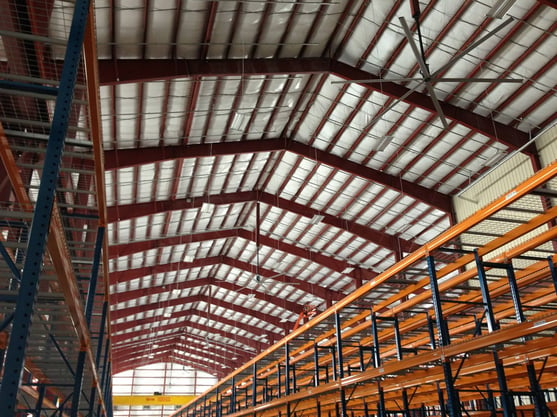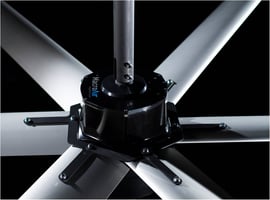Facility managers and engineers are always looking for the most efficient and cost-effective ways...
Engineering Review: Big Ceiling Fans vs. Wall Mounted Fans
With summer fast approaching, people are ready to purchase a new fan for their restaurant, gym, or small business. With rising energy costs, business owners are looking for cost savings anywhere they can. But what do choose…big ceiling fans vs. wall-mounted fans?
 I
I
t may be hard to decide which option is right for you and your commercial space. Both save floor space over more traditional fans, but that is where the similarities end. Let's take a look at what each fan type offers. You'll get perspective from MacroAir’s General Manager, Geoff Herkner, to decide for yourself.
Wall Mounted Fans: Does Size Really Matter?
An industrial wall-mount fan is different from a big ceiling fan in that it’s a fan found in an enclosed cage to prevent the blades from being exposed to passersby and to prevent injury. These fans are typically mounted onto a wall. They are designed to swivel back and forth to pass air from one corner of the room to the other. Sometimes wall fans are left off of their wall mount and instead placed on the ground.
“Typically the main point of differentiation is the difference in diameter. This also directly affects the max coverage area the fan can potentially affect.” - Geoff Herkner, Head of Engineering
Compared to big ceiling fans, wall fans are slightly less efficient. They often have less powerful motors, creating heavy energy consumption. . It takes multiple wall mounted fans to displace as much air as one big commercial ceiling fan, so the additional cost difference can be justified with simplicity, design, and potential energy savings.
“Wall mounted ceiling fans typically are smaller in diameter and produce air movement based on very high rotational speeds. Therefore, they are very inefficient.” - Geoff Herkner. Head of Engineering
Big Commercial Ceiling Fan, Big Difference

Small fans and blowers are typically used to cool large workspaces. However, the invention of industrial ceiling fans has changed that through the efficient and balanced airflow they provide.
The major benefit of using fewer large industrial ceiling fans instead of many smaller, faster wall mounted fans is energy consumption. Because of the large circumference and specially designed airfoils (a.k.a. blades), it only takes one large industrial ceiling fan to do the job of up to 34 traditional fan units. An average ceiling or tabletop fan spins several times the speed of a big industrial fan, which not only makes the fan noisy, but it also has higher power consumption..
“Big commercial ceiling fans will help reduce energy usage when placed properly. It will help cut down energy consumption in conjunction with HVAC units as well as individual heating units. This is due to the nature of the airflow of these large fans. They will equalize air temperature from floor to ceiling within minutes and therefore they have a strong affect on air turnover rates. This keeps customers’ HVAC or heating systems run-time to a minimum while maintaining the desired temperature set-point.” - Geoff Herkner. Head of Engineering
A commercial ceiling fan is capable of moving a lot more air than a commercial wall mounted fan. This is because they mount from above. Overhead fans move greater amounts of air through the entire space. Therefore, commercial spaces can be cooled more evenly.
“Large diameter fans are High Volume, Low Speed. The airflow is generated with an airfoil that is engineered to provide the maximum amount of airflow at the lowest rotational speed, providing greater efficiency.” - Geoff Herkner, Head of Engineering
Make a Comfortable Choice
The large, slow-moving columns of air created by industrial ceiling fans have a wider reach, create less noise, and operate more efficiently than traditional wall mounted fans. MacroAir even offers an outdoor ceiling fan option specifically designed to handle outdoor spaces.
MacroAir industrial fans are the latest in innovative big ceiling fan technology, providing a more efficient means of creating cooling comfort.
So, big ceiling fans vs. wall mounted fans? Can you feel a difference? Leave your comment below.


